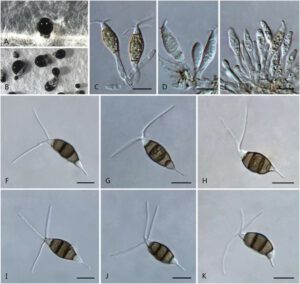Pestalotiopsis lushanensis F. Liu & L. Cai, in Liu, Hou, Raza & Cai, Scientific Reports 7(no. 866): 9 (2017)
Index Fungorum number: IF 818919; MycoBank number: MB 818919; Facesoffungi number: FoF 09397;
Etymology – named after the location where it was collected from, Lushan, Jiangxi Province.
Pathogenic to host leaves. Asexual state: Conidiomata pycnidial in culture on PDA, globose or clavate, aggregated or scattered, semi-immersed to erumpent, dark brown to black, up to 750 μm diam; exuding globose, dark brown to black conidial masses. Conidiophores reduced to conidiogenous cell; when present, septate near base, unbranches or branched at bases, subcylindrical, hyaline. Conidiogenous cell discrete or integrated, ampulliform, clavate or subcylindrical, hyaline, smooth-walled, wide at base, 8–40 × 4–6 μm. Conidia fusoid, ellipsoid, straight to slightly curved, 4-septate, slightly constricted at septa, 20–27 × 7.5–10 μm (av. ± SD = 22.3 ± 1.9 × 8.6 ± 0.6 μm); basal cell conic to obconic with a truncate base, hyaline, verruculose and thin-walled, 3–6 μm long; three median cells doliiform, 12–16.5 μm (av. ± SD = 14.2 ± 1.1 μm long), wall minutely verruculose, concolourous, pale brown to brown, septa darker than the rest of cell (second cell from base 3–5 μm long; third cell 3.5–6.5 μm long; fourth cell 3.5–6 μm long); apical cell 3.5–5.5 μm long, hyaline, obconic with a truncate base, thin-walled, verruculose; with 2–3 tubular apical appendages (mostly 3), arising from the apical crest, unbranched, filiform, 17–26 μm (av. ± SD = 20.3 ± 2.9 μm) long; basal appendage single, tubular, unbranched, centric, 4–6.5 μm long. Sexual morph unknown.
Culture characteristics – Colonies on PDA attaining 60 mm diam after 7 d at 25 °C, with undulate edge, pale honey-coloured, sparse aerial mycelia on the surface with black, gregarious conidiomata; reverse pale honey.
Material examined – China, Jiangxi Province, Lushan National Park, on Camellia sp., 5 Sep. 2013, Y.H. Gao, HMAS 247059 (holotype), ex-holotype living culture CGMCC 3.18160 (= LC4344); ibid. LC8182; ibid. LC8183.
Distribution – China
Sequence data – ITS: OM746282 (ITS1/ITS4); tef1: OM840054 (EF1-728F/EF2); tub2: OM839955 (Bt2a/Bt2b)
Notes – Pestalotiopsis lushanensis is most closely related to P. rhododendri and P. clavata (Fig. 2), but differs from P. rhododendri in forming longer apical (17–26 μm vs. 7.5–14.9 μm) and basal (4–6.5 μm vs. 2.8–4.9 μm) appendages, and from P. clavata in the shorter basal appendages (4–6.5 μm vs. 7–9 μm).

Fig. 1. Pestalotiopsis lushanensis(from ex-holotype culture CGMCC 3.18160 (= LC4344)). (A) Conidioma sporulating on pine needle. (B) Conidiomata sporulating on PDA. (C–E) Conidiogenous cells and conidia. (F–K) Conidia. Scale bars = 10 μm.
